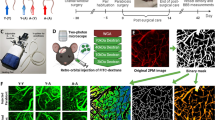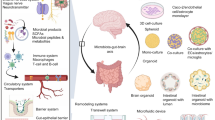Abstract
To analyze complex inflammatory responses in an in vitro system, we constructed a new 3D in vitro brain tissue model that exhibits in vivo-like tissue responses (e.g. immune cell phenotypes, and molecular response) to inflammatory stimuli. Finite element modeling of oxygen diffusion and cellular oxygen consumption predicted the oxygen profile within 3D structures, consisting of Type I collagen hydrogel embedded with murine microglia. Viability and cytotoxicity analyses supported the mathematical analysis, determining optimal cell growth conditions for 3D construct development. Real-time RT-PCR and ELISA demonstrated significant up-regulation of pro-inflammatory mediators, such as TNF-α, MCP-1, IL-6 and IL-1β, in lipopolysaccharide (LPS)-stimulated in vitro cell culture (2D and 3D) and in vivo mouse model systems. Interestingly, levels of inflammatory responses from the in vitro 3D model system were more similar to in vivo than in vitro 2D. Additionally, in situ dihydroethidium (DHE) assay and immunofluorescence staining revealed that levels of LPS-stimulated reactive oxygen species (ROS) generation and microglial activation from in vitro 3D model system were closer to in vivo than in vitro 2D. These results demonstrated that an in vitro 3D model provides more physiologically relevant pro-oxidative and pro-inflammatory environments in brain than an in vitro 2D model.







Similar content being viewed by others
References
Almendros, I., J. M. Montserrat, M. Torres, C. González, D. Navajas, and R. Farré. Changes in oxygen partial pressure of brain tissue in an animal model of obstructive apnea. Respir. Res. 11:3, 2010.
Ardakani, A. G., U. Cheema, R. A. Brown, and R. J. Shipley. Quantifying the correlation between spatially defined oxygen gradients and cell fate in an engineered three-dimensional culture model. J. R. Soc. Interface 11:20140501, 2014.
Block, M. L., L. Zecca, and J. S. Hong. Microglia-mediated neurotoxicity: uncovering the molecular mechanisms. Nat. Rev. Neurosci. 8:57–69, 2007.
Carreau, A., B. El Hafny-Rahbi, A. Matejuk, C. Grillon, and C. Kieda. Why is the partial oxygen pressure of human tissues a crucial parameter? Small molecules and hypoxia. J. Cell. Mol. Med. 15:1239–1253, 2011.
Cho, H. J., V. S. Sajja, P. J. Vandevord, and Y. W. Lee. Blast induces oxidative stress, inflammation, neuronal loss and subsequent short-term memory impairment in rats. Neuroscience 253:9–20, 2013.
Cox, M. C., L. M. Reese, L. R. Bickford, and S. S. Verbridge. Toward the broad adoption of 3D tumor models in the cnacer drug pipeline. ACS Biomater. Sci. Eng. 1:877–894, 2015.
Cukierman, E., R. Pankov, D. R. Stevens, and K. M. Yamada. Taking cell-matrix adhesions to the third dimension. Science 294:1708–1712, 2001.
Cullen, D. K., J. A. Wolf, V. N. Vernekar, J. Vukasinovic, and M. C. LaPlaca. Neural tissue engineering and biohybridized microsystems for neurobiological investigation in vitro (Part 1). Crit. Rev. Biomed. Eng. 39:201–240, 2011.
DelNero, P., M. Lane, S. S. Verbridge, B. Kwee, P. Kermani, B. Hempstead, A. Stroock, and C. Fischbach. 3D culture broadly regulates tumor cell hypoxia response and angiogenesis via pro-inflammatory pathways. Biomaterials 55:110–118, 2015.
Fang, M., E. L. Goldstein, E. K. Matich, B. G. Orr, and M. M. Holl. Type I collagen self-assembly: the roles of substrate and concentration. Langmuir 29:2330–2338, 2013.
Geckil, H., F. Xu, X. Zhang, S. Moon, and U. Demirci. Engineering hydrogels as extracellular matrix mimics. Nanomedicine (Lond) 5:469–484, 2010.
Griffith, L. G., and M. A. Swartz. Capturing complex 3D tissue physiology in vitro. Nat. Rev. Mol. Cell. Biol. 7:211–224, 2006.
Grinnell, F. Fibroblast biology in three-dimensional collagen matrices. Trends Cell. Biol. 13:264–269, 2003.
Haw, R. T., C. K. Tong, A. Yew, H. C. Lee, J. B. Phillips, and S. Vidyadaran. A three-dimensional collagen construct to model lipopolysaccharide-induced activation of BV2 microglia. J. Neuroinflamm. 11:134, 2014.
Hu, X., A. K. Liou, R. K. Leak, M. Xu, C. An, J. Suenaga, Y. Shi, Y. Gao, P. Zheng, and J. Chen. Neurobiology of microglial action in CNS injuries: receptor-mediated signaling mechanisms and functional roles. Prog. Neurobiol. 119–120:60–84, 2014.
Jokinen, J., E. Dadu, P. Nykvist, J. Käpylä, D. J. White, J. Ivaska, P. Vehviläinen, H. Reunanen, H. Larjava, L. Häkkinen, and J. Heino. Integrin-mediated cell adhesion to type I collagen fibrils. J. Biol. Chem. 279:31956–31963, 2004.
Kettenmann, H., U. K. Hanisch, M. Noda, and A. Verkhratsky. Physiology of microglia. Physiol. Rev. 91:461–553, 2011.
Lee, W. H., W. E. Sonntag, M. Mitschelen, H. Yan, and Y. W. Lee. Irradiation induces regionally specific alterations in pro-inflammatory environments in rat brain. Int. J. Radiat. Biol. 86:132–144, 2010.
Luo, X. G., J. Q. Ding, and S. D. Chen. Microglia in the aging brain: relevance to neurodegeneration. Mol. Neurodegener. 5:12, 2010.
O’Connor, S. M., D. A. Stenger, K. M. Shaffer, D. Maric, J. L. Barker, and W. Ma. Primary neural precursor cell expansion, differentiation and cytosolic Ca2+ response in three-dimensional collagen gel. J. Neurosci. Methods 102:187–195, 2000.
Okazaki, K., and E. Maltepe. Oxygen, epigenetics and stem cell fate. Regen. Med. 1:71–83, 2006.
Pöttler, M., S. Zierler, and H. H. Kerschbaum. An artificial three-dimensional matrix promotes ramification in the microglial cell-line, BV-2. Neurosci. Lett. 410:137–140, 2006.
Riedl, A., M. Schlederer, K. Pudelko, M. Stadler, S. Walter, D. Unterleuthner, C. Unger, N. Kramer, M. Hengstschlager, L. Kenner, D. Pfeiffer, G. Krupitza, and H. Dolznig. Comparison of cancer cells in 2D vs 3D culture reveals differences in AKT-mTOR-S6 K signaling and drug responses. J. Cell Sci. 130:203–218, 2017.
Skardal, A., M. Devarasetty, H. W. Kang, I. Mead, C. Bishop, T. Shupe, S. J. Lee, J. Jackson, J. Yoo, S. Soker, and A. Atala. A hydrogel bioink toolkit for mimicking native tissue biochemical and mechanical properties in bioprinted tissue constructs. Acta Biomater. 25:24–34, 2015.
Song, Q., Z. Jiang, N. Li, P. Liu, L. Liu, M. Tang, and G. Cheng. Anti-inflammatory effects of three-dimensional graphene foams cultured with microglial cells. Biomaterials 35:6930–6940, 2014.
Stamati, K., V. Mudera, and U. Cheema. Evolution of oxygen utilization in multicellular organisms and implications for cell signalling in tissue engineering. J. Tissue Eng. 2:2041731411432365, 2011.
Streeter, I., and U. Cheema. Oxygen consumption rate of cells in 3D culture: the use of experiment and simulation to measure kinetic parameters and optimise culture conditions. Analyst 136:4013–4019, 2011.
Tibbitt, M. W., and K. S. Anseth. Hydrogels as extracellular matrix mimics for 3D cell culture. Biotechnol. Bioeng. 103:655–663, 2009.
Toborek, M., Y. W. Lee, S. Kaiser, and B. Hennig. Measurement of inflammatory properties of fatty acids in human endothelial cells. Methods Enzymol. 352:198–219, 2002.
Verbridge, S. S., N. W. Choi, Y. Zheng, D. J. Brooks, A. D. Stroock, and C. Fischbach. Oxygen-controlled three-dimensional cultures to analyze tumor angiogenesis. Tissue Eng. Part A 16:2133–2141, 2010.
Acknowledgments
The authors are thankful to Nabil Boutagy, Ph.D., Department of Medicine, Yale University School of Medicine, for his vital assistance with the Seahorse XF24 analyzer.
Author information
Authors and Affiliations
Corresponding author
Additional information
Associate Editor Jennifer West oversaw the review of this article.
Rights and permissions
About this article
Cite this article
Cho, H.J., Verbridge, S.S., Davalos, R.V. et al. Development of an In Vitro 3D Brain Tissue Model Mimicking In Vivo-Like Pro-inflammatory and Pro-oxidative Responses. Ann Biomed Eng 46, 877–887 (2018). https://doi.org/10.1007/s10439-018-2004-z
Received:
Accepted:
Published:
Issue Date:
DOI: https://doi.org/10.1007/s10439-018-2004-z




